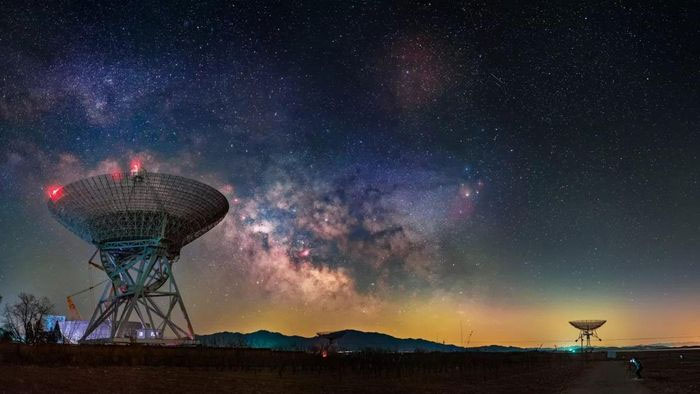8 Possible Alien Signals Detected Around Distant Stars
Eight signals from distant stars found by new method show promise in finding real aliens. Using a new algorithm, scientists have picked up eight extraterrestrial signals that appear to bear the hallmarks of technology.
The research team, led by experts from the University of Toronto, used a new algorithm to sort through data from the telescope, in order to distinguish between extraterrestrial and artificial signals.
This allowed them to quickly sort through the information through a machine learning process. The study's authors suggest that artificial intelligence will help increase the ability to search for signals from other civilizations.
8 extraterrestrial signals detected

Radio telescopes scan the universe for signs of extraterrestrial intelligence.
'I'm impressed by how well this approach has performed in the search for extraterrestrial intelligence,' said Cherry Ng, an astronomer at the University of Toronto in Canada and co-author of the study. ' With the help of artificial intelligence, I'm optimistic that we will be able to better quantify the likelihood of extraterrestrial signals from other civilizations.'
First, the researchers designed an algorithm to tell the difference between man-made radio signals originating on Earth and radio signals coming from elsewhere. ( Radio waves are a popular target in the search for extraterrestrial intelligence, or SETI, because they can travel long distances through space.)
The researchers tested different algorithms to minimize false positives. They analyzed 150 terabytes of data from the Green Bank Telescope in West Virginia, including observations of 820 stars near Earth. They then discovered eight previously overlooked signals from five stars located between 30 light-years and 90 light-years from Earth.
Breakthrough Listen scientists say these signals have two characteristics in common with signals that could be produced by intelligent aliens.
' First , they are present when we look at the star and absent when we look away — in contrast to local interference, which is always present . Second , the signals change frequency over time in a way that makes them appear farther away from the telescope ,' Steve Croft, project scientist for Breakthrough Listen at Green Bank Telescope, said in the statement.
However, it is possible that these features could arise by chance. And before making any claims about distant alien life, researchers will need to repeatedly observe similar signals.
The team hopes to apply their algorithm to data from powerful radio telescopes, such as MeerKAT in South Africa, which is planned to be located across North America.
'With our new technique, combined with the next generation of telescopes, we hope that machine learning can take us from searching hundreds of stars to searching millions of stars,' said the project 's lead researcher .
Detecting extraterrestrial signals using AI
To distinguish extraterrestrial signals from human-made radio waves, the team trained their machine learning tools by simulating both types of signals. They tested several different algorithms, evaluating their accuracy, and eventually settled on a powerful algorithm created by Peter Ma .
First, the researchers designed an algorithm to tell the difference between human-generated radio signals originating on Earth and radio signals coming from elsewhere.
Ma's algorithm, which combines two machine learning techniques, supervised and unsupervised, allows the algorithm to generalize information, leading to better results in searching for extraterrestrial signals.

Peter Ma, creator of an algorithm that speeds up the detection of extraterrestrial signals. (Photo: Adar Kahiri).
Mr. Peter Ma revealed that the idea for this algorithm only started as a project in high school and was not really appreciated by his teachers.
Still, Dr Ng said new ideas were important in a field like SETI. 'By scanning all the data with a new technique, we were able to discover interesting signals'
The team hopes to apply their algorithm to data from more powerful radio telescopes, such as MeerKAT in South Africa.
'With our new technique, combined with the next generation of telescopes, we hope that machine learning can take us from searching hundreds of stars to millions of stars ,' said Ma.
- Detecting 11 suspected alien radio signals
- Detect suspicious signals of aliens from more than 230 stars
- Interstellar travel objects have no alien signals
- The first time the signal of the oldest stars in the universe was detected
- Look for strange signals from distant exoplanets
- New hypothesis about the signal 'Wow!' Comfort of aliens
- Decoding alien signals 40 years ago
- The alien signal constantly bounces off the Earth every second
- Giant telescope captures signals from the universe
- Most likely we have caught signals from aliens
- Image simulating living creatures on the planet near red dwarfs
- The mysterious, inexplicable signals from space
 Van Allen's belt and evidence that the Apollo 11 mission to the Moon was myth
Van Allen's belt and evidence that the Apollo 11 mission to the Moon was myth The levels of civilization in the universe (Kardashev scale)
The levels of civilization in the universe (Kardashev scale) Today Mars, the sun and the Earth are aligned
Today Mars, the sun and the Earth are aligned The Amazon owner announced a secret plan to build a space base for thousands of people
The Amazon owner announced a secret plan to build a space base for thousands of people